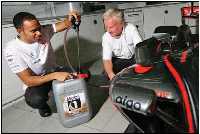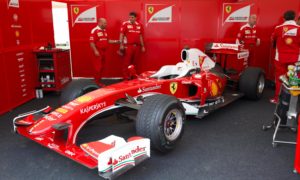 Formula One engine development may be banned until 2013, with Max Mosley and the FIA’s latest efficiency drive unlikely to reverse the freeze beyond that, but that hasn’t stopped teams looking at just about every other means of squeezing crucial tenths of a second from their V8 beasts.
Formula One engine development may be banned until 2013, with Max Mosley and the FIA’s latest efficiency drive unlikely to reverse the freeze beyond that, but that hasn’t stopped teams looking at just about every other means of squeezing crucial tenths of a second from their V8 beasts.
Vodafone McLaren Mercedes are no exception. As Lewis Hamilton scythed his way through the rain-soaked chaos to victory at Silverstone, sending shockwaves ripping through the 90,000-strong capacity crowd, beneath the carbon fibre of his MP4-23, energy of an altogether different kind that of his Mercedes engine’s volcanic combustion cycle was being tamed, harnessed and converted into raw lap-time by McLaren’s new weapon in the F1 arms race…
New Technology Mobil 1, colloquially known in McLaren engineering circles as “lap-time in a can”, is the team’s new fuel and oil mixture combination, introduced for the first time at Silverstone after extensive research and development with partners ExxonMobil.
The new mixture builds on the traditional function of oil lubricants by reducing wear and improving the reliability of components, thereby delivering significantly more ‘bangs per buck’ in the context of the 2008-13 engine freeze, lifelong gearboxes, and the requirement for engines to last two races.
But where McLaren and ExxonMobil have made an even more significant breakthrough in performance is in reducing the colossal amount of energy that escapes from the engine as its pistons and rotors faced with a violent combustion cycle of 19,000rpm and accelerative forces of nearly 9000 times gravity churn their way though the very liquid that has been put in place to preserve them and stop them breaking down.
“The new oils help in terms of reliability but we have to remember that while you have high-speed rotating parts sloshing through oil you still get churning losses in there,” explains McLaren Racing’s Managing Director Jonathan Neale, “so filling the thing full of oil is not smart from a weight point of view. Also, you get losses caused by just motoring rotating parts through a viscous liquid.
“What we want to do is run with the minimum amount of oil that we need to maintain a film in the areas that we need it. If you imagine the bottom end of a crank motoring through a slump of gloopy oil, there are going to be losses just from motoring through the liquid. So you really want to run as little oil as possible in the slump but you want to squirt it in a very fine mist to all the places that really need it.
“It’s a bit like trying to run through mud in wellington boots. If you’re running on firm ground that’s coated in mud, you’re going to be running in a shallow, viscous liquid. As a result, you’re going to be travelling a lot quicker than if you were trying to run through deep, sludgy mud.”
The exact make-up of New Technology Mobil 1 remains a closely guarded secret; suffice it to say, though, that ExxonMobil have produced a mixture that greases the components enough to prevent wear, but using a significantly thinner liquid or film. This film is targeted at the components most in need the engine, gearbox, and wheel bearings and allows energy that would otherwise be lost by powering rotors through a more viscous liquid to be transferred to other areas of the car, notably the rear wheels, where it generates torque and traction and significantly improves lap-time.
“What our partners at ExxonMobil have been able to provide for us is for more of the efficiency in the engine to be delivered to the rear wheels and for less of it to be consumed in motoring parts in oil,” Neale explains. “So the oils are becoming increasingly less viscous, but they still provide a very good oil film. And that really does confer lap-time benefits.”
With the push in Formula One to reduce costs and make the sport greener, developments in engine performance and efficiency are beginning to challenge the age-old design philosophy that the perfect race car is the one that takes the chequered flag first, and then falls to pieces.
“If you take the Colin Chapman view of Formula One racing, then if your car goes one metre over the line you’re carrying waste in it,” says Neale. “But the reality these days is that there are heavy penalties for failure to achieve reliability. Formula One has never been very fault-tolerant. Ferrari showed for many years that it was entirely possible to maintain high degrees of engineering change while not compromising high reliability.
“I remember the days when we used to turn up in Australia and only 40 per cent of the cars would finish the race, while the other 60 per cent were parked on the grass somewhere. Those days are long gone; we’ve now come to expect no loss in performance, continuous improvement, and very high reliability too.
While huge strides in development have been made, there is still no substitute for having a first-class driver behind the wheel as Lewis Hamilton demonstrated to such good effect at Silverstone last Sunday.
“In a rain-affected race like the 2008 Santander British Grand Prix, your driver contribution is very big indeed. The ability to concentrate and focus when he’s got a car that’s continually trying to break away from him is so important. He’s trying to navigate back-markers and he’s simultaneously trying to find dry areas on which to get the tyres to adhere to the road to get purchase – and then down the straight he’s trying cool those tyres down and thereby look after them as well.
“In semi-dry conditions it’s very easy to lose whole seconds off the performance of the tyres. We’ve just spent weeks, months and years trying to improve our car by a few tenths of a second, but one bad move by a driver or a careless failure by a driver to optimise the process of looking after the tyre, and it’s all over. And as we saw at Silverstone there were some cars and drivers running at four, five or even six seconds a lap difference in performance.”








